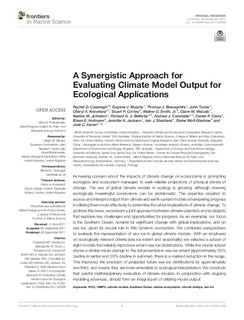A Synergistic Approach for Evaluating Climate Model Output for Ecological Applications
Cavanagh, Rachel D.; Murphy, Eugene J.; Bracegirdle, Thomas J.; Turner, John; Knowland, Cheryl A.; Corney, Stuart P.; Smith, Walker O.; Waluda, Claire M.; Johnston, Nadine M.; Bellerby, Richard; Constable, Andrew J.; Costa, Daniel P.; Hofmann, Eileen E.; Jackson, Jennifer A.; Staniland, Iain J.; Wolf-Gladrow, Dieter; Xavier, Jose C.
Journal article, Peer reviewed
Published version
Permanent lenke
http://hdl.handle.net/11250/2507064Utgivelsesdato
2017Metadata
Vis full innførselSamlinger
- Publikasjoner fra Cristin - NIVA [2160]
- Scientific publications [1172]
Sammendrag
Increasing concern about the impacts of climate change on ecosystems is prompting ecologists and ecosystem managers to seek reliable projections of physical drivers of change. The use of global climate models in ecology is growing, although drawing ecologically meaningful conclusions can be problematic. The expertise required to access and interpret output fromclimate and earth systemmodels is hampering progress in utilizing them most effectively to determine the wider implications of climate change. To address this issue, we present a joint approach between climate scientists and ecologists that explores key challenges and opportunities for progress. As an exemplar, our focus is the Southern Ocean, notable for significant change with global implications, and on sea ice, given its crucial role in this dynamic ecosystem. We combined perspectives to evaluate the representation of sea ice in global climate models. With an emphasis on ecologically-relevant criteria (sea ice extent and seasonality) we selected a subset of eight models that reliably reproduce extant sea ice distributions. While the model subset shows a similar mean change to the full ensemble in sea ice extent (approximately 50% decline in winter and 30% decline in summer), there is a marked reduction in the range. This improved the precision of projected future sea ice distributions by approximately one third, and means they are more amenable to ecological interpretation. We conclude that careful multidisciplinary evaluation of climate models, in conjunction with ongoing modeling advances, should form an integral part of utilizing model output.

